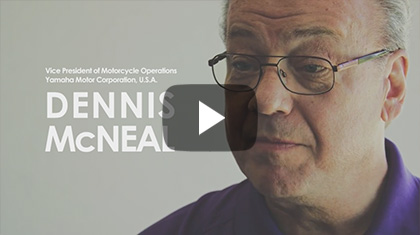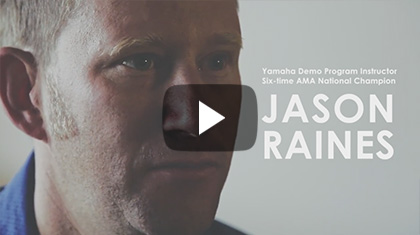In October 2016, the PED2 electric mountain trail motorcycle prototype—the same model that was on display at the previous Tokyo Motor Show—was at a plot of land near Yamaha Motor headquarters in Japan. Ridden by 2015 All Japan Ladies Class Motocross Champion Saya Yasuhara, the PED2 takes off smoothly and without the signature sound of an exhaust pipe. What did she feel from a machine that represents the current state of EV technology in a motorcycle? The futuristic off-road bike accelerated and disappeared across the grass field without a sound.
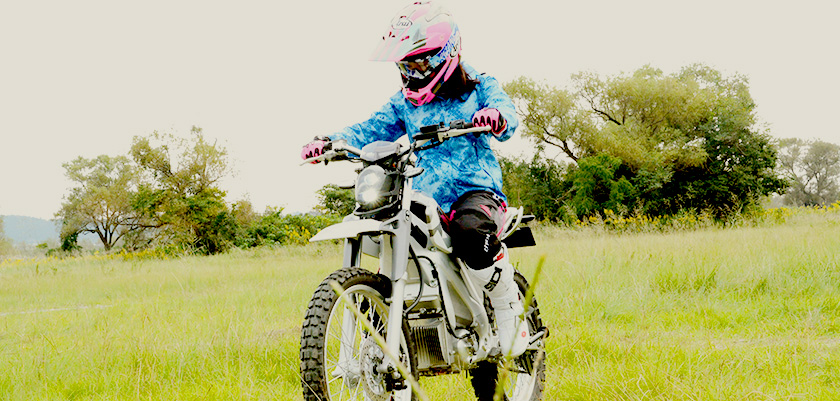 Saya Yasuhara on the PED2
Saya Yasuhara on the PED2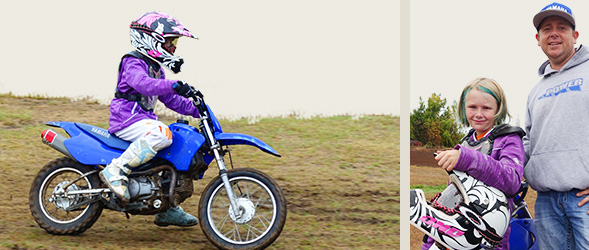 A young rider on a TT-R90 at a demo-ride event in Albany, Oregon
A young rider on a TT-R90 at a demo-ride event in Albany, OregonYamaha riders continue to challenge themselves day after day all across the world. On a Sunday in September, there was a slight drizzle falling at the motocross course at Albany Motorsports Park on the outskirts of Albany, Oregon in the United States. But despite the wet weather, one young girl was having a lot of fun riding a TT-R90 around the flat track course. “Jason taught me how to ride here a year ago,” she said. “Since then I’ve been coming and having fun every couple of months. I wonder if I can ride a different bike today.” When asked what she thought of motorcycles, “They’re cool,” was her slightly shy response. Under her father’s warm gaze, this 9-year-old girl was beginning her challenge towards a future full of potential still unknown to her.
There was a Yamaha Demo Program taking place there that day. From the TT-R50E to the YZ450F, Yamaha’s full lineup of off-road models were present and available for participants to take out for a free test ride. The man behind this program is six-time AMA National Hare Scrambles Champion Jason Raines.
The latest 2017 year models were lined up that day as well. Among the participants were a father and his daughter who had come to check out the YZ85, a student who had come with his mother with the goal of riding a 250cc motocross machine for the first time, and others that wanted to compare Yamaha to other brands; there was a wide variety of rider skill levels and many different aims for attending the event. Using a tablet, check-in for the event was swift and the rider’s level was determined through a brief conversation before initial advice was provided based on that. Those trying the YZ250F for the first time were instructed in use of the throttle and in the basics of riding the bike in a figure-eight pattern. Each rider’s personal challenge was supported with guidance fitting their level.
The Yamaha Demo Program began in 2010, and there were only about 10 or 15 people at each event at first. But as time went on and more were held, that number increased and in 2015, some 14,000 people attended these events. During the on-season, that meant that every weekend there was a demo-ride event going on somewhere, and the states not visited over the course of a year numbered less than ten. Jason Raines talks about the program:
“We do a little bit of teaching during the demo program, but our primary focus is introducing the kids to a new sport and getting them engaged in the brand. We see just about every different customer type you could possibly imagine in the United States, from riders that are excited to try something new, and then the riders that are completely new to the sport. We have families come out so much where they’re wanting their children to get involved in something besides sitting on the couch.
“They’ll come out and we’ll show them how to ride and some riders catch on to it. Then the next thing you know, you’ve got the son or the daughter riding, well then the parents decide to ride, so now you’ve gone from having one person that can’t ride to having three people that can ride.
“Every year the program grows, and what we see is word of mouth. So we do an event say in Seattle, and then next year, we do the same event. The people who came have told a bunch of their friends about it. They talk about how fun the events are and the ability to ride a brand-new Yamaha. We have people that give us social media comments all the time like ‘When are you coming back?’ ‘When are you going do this event again?’ ‘Where are you going to be next week?’ Some places we can’t hit but once a year, and customers know that we’re only coming in once a year so when we do that event they all get together and come out to try the motorcycles.”
Jason’s passion and zeal for the challenge of spreading off-road riding’s popularity through these kinds of events was all-too-clear as he spoke.
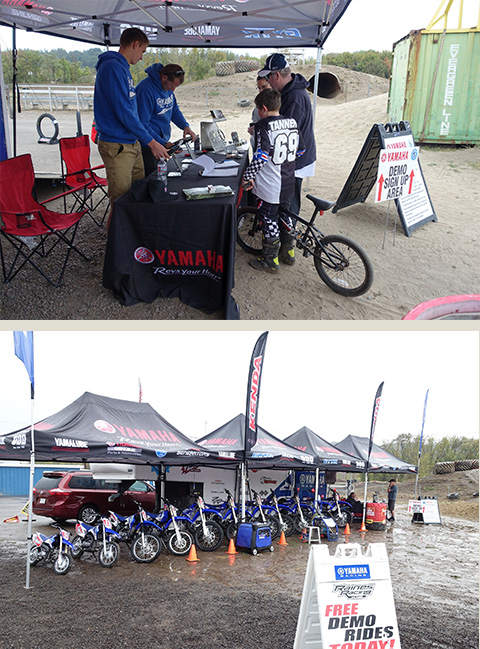 Check-in for a Yamaha Demo Program
Check-in for a Yamaha Demo Program
The “bLU cRU” is a program started in 2014 by Yamaha Motor Corporation, U.S.A. (YMUS) to support Yamaha riders who ride competitively, and it is one way Yamaha is taking on the challenge of energizing off-road racing.
It was introduced in Japan in 2016 as a support program for YZ owners who race their machines, and preparations are underway to introduce it in Taiwan, Australia and other countries as well. The program offers everything from training events for riders to hone their skills to exchanging information over the internet. It is part of the “soft” aspect of promoting Yamaha’s off-road lineup, but the origins can be traced all the way to the 1970s.
With the popularization of off-road riding that began with the DT-1, Yamaha started offering trail riding courses and holding “Sport & Leisure (SL) Races” primarily in Japan, building up a strong partnership with off-road customers.
A similar kind of program was being run in the U.S. at around the same time, called the “Yamaha Team Center.” YMUS created it aiming at off-road riders interested in racing and provided information to dealers, organized races, facilitated interaction with customers at race events and distributed race kit parts. But what’s the difference between the Yamaha Team Center of the ‘70s and today’s bLU cRU currently spreading from the U.S. into Japan and other countries? Dennis McNeal, Vice President of Motorcycle Operations at YMUS, answers from the Yamaha Motor offices on the outskirts of Los Angeles:
“It’s exactly the same!” was Dennis’ emphatic answer. “We still support the dealer with the parts to modify the bikes, but technology, whether on the models themselves or through communication of social media, videos and the internet, has really changed the dynamic along with the customer changing demographically. From one generation to another, the needs on how you communicate have changed over time. The bLU cRU initiative really is a riders’ initiative. Our resources are provided directly to the rider. We created a platform on our website and through social media where they could talk to each other, where they could present their own ideas and really open up the communication, not to exclude the dealer, but to include the customer with the factory’s communication to the dealer.”
 A bLU cRU members event held in 2016 at Jiigatake in Japan
A bLU cRU members event held in 2016 at Jiigatake in Japan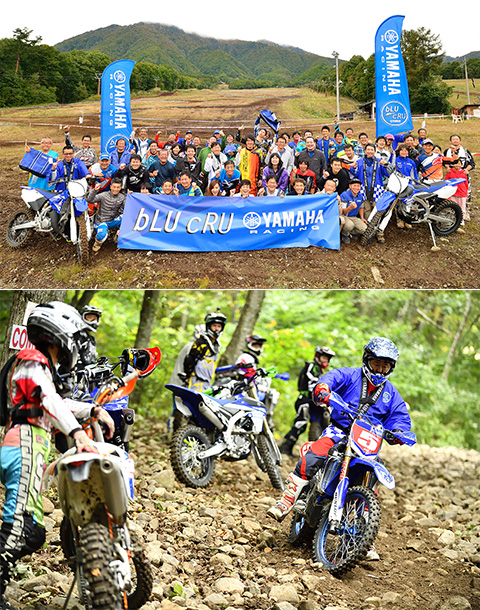 A bLU cRU members event held in 2016 at Jiigatake in Japan
A bLU cRU members event held in 2016 at Jiigatake in Japan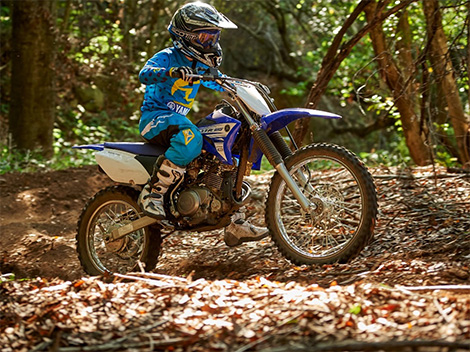 The TT-R125
The TT-R125
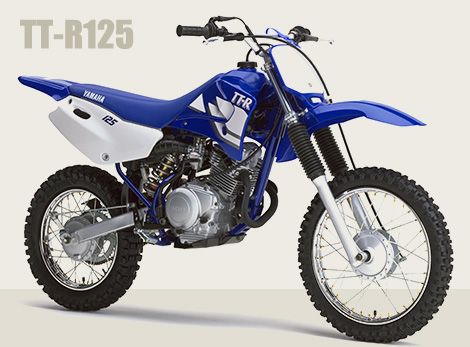 The TT-R125 debuted in 2000
The TT-R125 debuted in 2000
The model that has proven to be popular at these off-road demo events held around the U.S. is the TT-R125. You cannot talk about Yamaha’s off-road spirit without mentioning this bike. Things began in the late-1990s. The 4-stroke YZ400F production bike had been introduced in preparation for the 1998 racing season and the YZ brand of off-road machines was shining brightly. But Yamaha couldn’t be satisfied with only great results in top-level race series like the AMA championships and the Motocross World Championship. The TT-R90 had been released and was inspiring children’s dreams of riding, but its size wasn’t intended for adults. Seeing children having so much fun on the TT-R90 made parents conjure dreams of their own for a bike that was affordable and easy to have fun on. Though an 80cc motocross bike was available at the time, having fun on the ride was more attractive than desiring outright speed, and Yamaha’s off-road enthusiasts felt the same.
Established in 1992, Chongqing Jianshe Yamaha Motor Co., Ltd. (CJYM) was the first joint venture company in China for Japanese motorcycles. Towards the end of the 1990s, Yamaha Motor headquarters and CJYM were in the midst of planning a road-going 125cc model suited to the Chinese market. The product planning team from Yamaha headquarters that was constantly travelling between Japan, China and the U.S. at the time was actually full of serious off-road enthusiasts. One day they had a breakthrough: “This 125cc engine has got serious potential for use in a fun off-road bike.” After further deliberation and discussion, the direction to take in this challenge came together and the planning, development and engineering proceeded smoothly. This was because they already had plenty of know-how from designing YZs, and the end result was none other than the TT-R125. Created under the concept of a fun machine capable of a wide range of uses, it debuted in Japan in 2000. The 125cc engine was modified specifically for the TT-R and had a built-in balancer, SOHC format, two valves and a bore×stroke of 54×54 mm. The bike came with a 5-speed manual transmission, 19-inch front tire and 16-inch rear tire.
Its light, 84 kg weight and body size fit beginners as well as a wide range of riders. The natural feel to the steering and its handling characteristics gave confidence to riders intending to step up to a bigger machine and a higher skill level, and it won the praise of more experienced riders who loved the exhilaration of riding it at full throttle. It also served well as a lead bike for guiding children riding PW50s. Yamaha’s off-road lineup is organized as a pyramid to encourage progress to higher levels of performance, and the TT-R125 covers the widest range as a bridge to connect the most users. It’s a 125cc machine that supports riders as they challenge themselves to higher levels of skill on the dirt.
The challenges and results of digitalization in the motorcycle industry were epoch-making. The YZ450F, which was announced in 2009 and released the following year, was Yamaha’s first fuel-injected YZ model. However, it wasn’t simply about incorporating fuel injection or adding in more electronics, but rather a fastidious goal to improve off-road potential and performance. The trend at the time was to introduce fuel injection into production motocross models, and in terms of adopting the technology, one could say Yamaha was among the latest to do so. However, the majority of first-generation fuel-injected models had simply swapped in a fuel injection system where the carburetor had been located previously. In developing the YZ450F, Yamaha refused that approach. With a focus on mass centralization as the bedrock for developing excellent handling performance, the project began completely from scratch. Adding fuel injection was not a prerequisite, but instead the challenge for the engineers was how to best utilize fuel injection to produce a great ride.
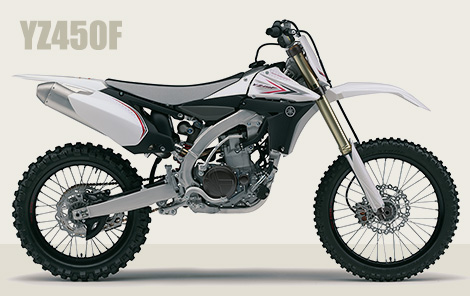 The YZ450F released in 2010 took full advantage of the merits of fuel injection.
The YZ450F released in 2010 took full advantage of the merits of fuel injection.
 YZ450F exhaust pipe and muffler (left); YZ450F engine internals (center); Power Tuner (right)
YZ450F exhaust pipe and muffler (left); YZ450F engine internals (center); Power Tuner (right)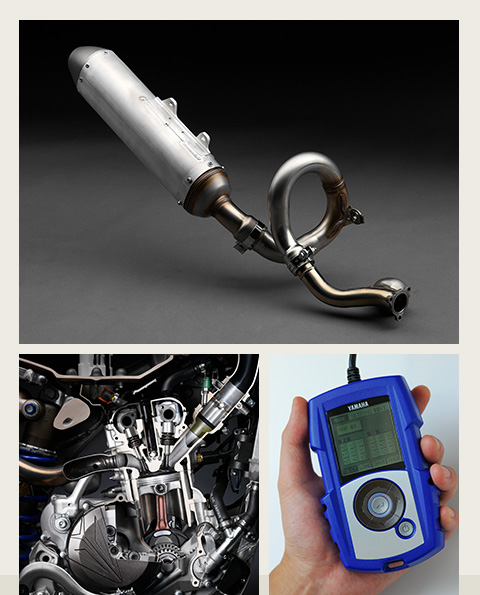 YZ450F exhaust pipe and muffler (left); YZ450F engine internals (center); Power Tuner (right)
YZ450F exhaust pipe and muffler (left); YZ450F engine internals (center); Power Tuner (right)The team took advantage of the greater degree of freedom allowed with the positioning of the fuel tank and the layout of the intake/exhaust valves afforded by a fuel injection system’s more space-efficient design. The answer they arrived at was a design with the cylinder tilted rearward, with a straight intake duct running to a port at the front of the block and the exhaust port facing the rear of the block. Air brought in through the duct at the front passed through the air cleaner in the middle of the chassis and then on to the intake port. Following combustion, the exhaust pipe wrapped once around the cylinder like a scarf. This layout achieved both great performance and mass centralization. Since the intake port is located at front, it avoids the effects of engine heat and makes it more difficult to suck in dust or debris kicked up by the machine itself.
In addition, the fun of modifying engine settings was made easier thanks to digital technology. Fuel injection automatically adjusts fuel delivery according to the ride environment to improve ride quality, but with it, the ease and enjoyment of manually modifying engine settings was lost. Off-road enthusiasts and technicians certainly felt this way. So, debuting alongside the YZ450F was the smartphone-sized Power Tuner. Fuel injection volume and ignition timing characteristics could be tuned based on preset maps and made it possible for riders to modify their machine to suit personal preference.
Normally, the flow of setting up a motocross machine is said to be adjusting the riding position first, then suspension adjustments and then engine settings, but there are no firm rules in place. A motorcycle is ridden and operated by a person, so it’s ultimately down to the rider’s abilities and sensitivity to changes. The Power Tuner allows users to start making adjustments from where they choose to focus on, and acts as a simple gateway for users to enter the world of off-road machine modification. The Power Tuner later expanded in compatibility to include other 4-stroke YZ and YZ-FX models. The stance of Yamaha’s off-road enthusiasts and the company’s approach to the category could be seen in the footprints left behind in the march towards digitalization.
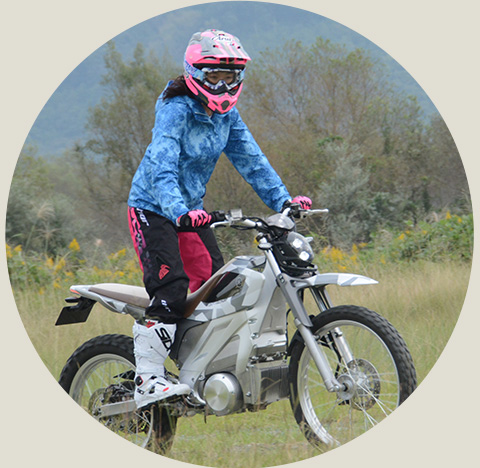
Yasuhara returns after receiving the signal that her test-ride was over. “This is sooo much fun!” she exclaims as she carefully removes her helmet. “Before I started off, the quietness felt really good. The acceleration? It’s great. It might even accelerate faster than my YZ85LW. It went faster than I thought it would. I think it could make the jumps on a track. It’s really an interesting machine.”
Yamaha’s off-road enthusiasts are also engaged in the PED2’s research and development. In answer to Yasuhara’s assessment, they had this to say: “We’re challenging ourselves with a wide range of EV-related themes. The lithium-ion batteries we’ve developed are currently equipped on the PED2. It’s not just about the future potential. By conducting R&D on batteries, we’re able to gather a lot of data. We can also look for solutions for how to use electricity in a way that it isn’t hard on the battery. Also, with an EV, the torque characteristics differ from a gasoline engine, and the machine’s weight distribution is also different because of the power unit’s size and weight. Sound is also an important element. The sound of the motor, the brakes, the tires, the chain and more all come into play eventually, but we’re trying as much as possible to eliminate unpleasant sounds reaching the rider’s ear.”
Yamaha does not see EV machines as simply an opportunity to help solve global environmental issues, but to leverage the unique advantages they offer to produce a fun ride that can only be had on an EV. This is Yamaha Motor’s challenge for the next generation of off-road machines.
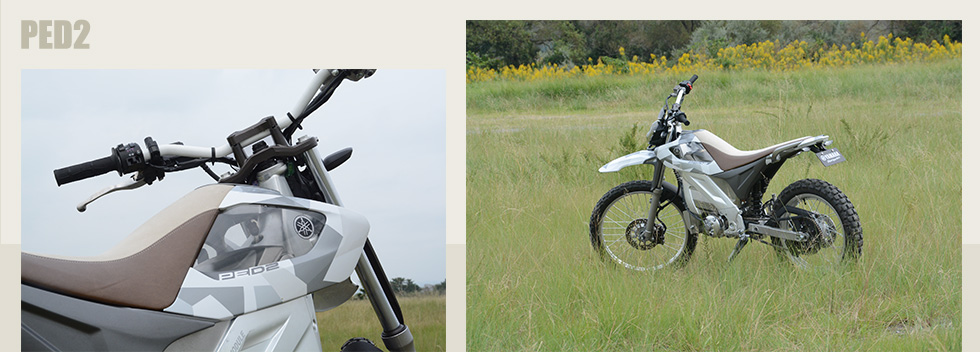 R&D for the PED2 is currently underway.
R&D for the PED2 is currently underway.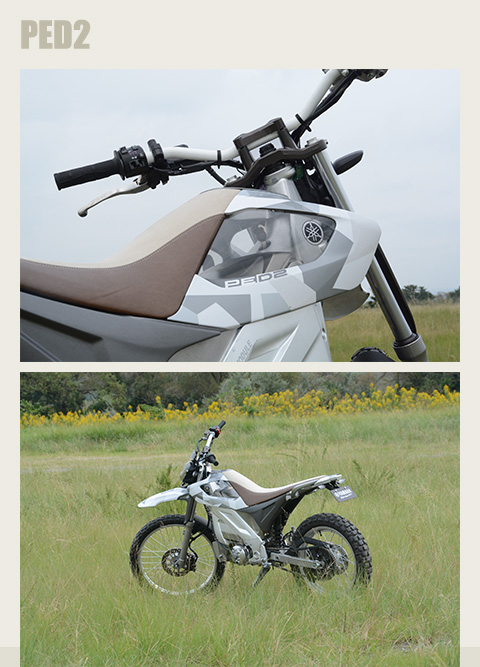 R&D for the PED2 is currently underway.
R&D for the PED2 is currently underway.







